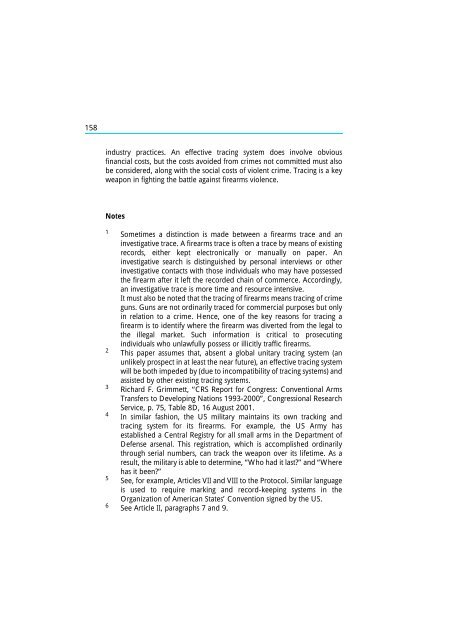The Scope and Implications of a Tracing Mechanism for Small Arms ...
The Scope and Implications of a Tracing Mechanism for Small Arms ...
The Scope and Implications of a Tracing Mechanism for Small Arms ...
Create successful ePaper yourself
Turn your PDF publications into a flip-book with our unique Google optimized e-Paper software.
158<br />
industry practices. An effective tracing system does involve obvious<br />
financial costs, but the costs avoided from crimes not committed must also<br />
be considered, along with the social costs <strong>of</strong> violent crime. <strong>Tracing</strong> is a key<br />
weapon in fighting the battle against firearms violence.<br />
Notes<br />
1<br />
Sometimes a distinction is made between a firearms trace <strong>and</strong> an<br />
investigative trace. A firearms trace is <strong>of</strong>ten a trace by means <strong>of</strong> existing<br />
records, either kept electronically or manually on paper. An<br />
investigative search is distinguished by personal interviews or other<br />
investigative contacts with those individuals who may have possessed<br />
the firearm after it left the recorded chain <strong>of</strong> commerce. Accordingly,<br />
an investigative trace is more time <strong>and</strong> resource intensive.<br />
It must also be noted that the tracing <strong>of</strong> firearms means tracing <strong>of</strong> crime<br />
guns. Guns are not ordinarily traced <strong>for</strong> commercial purposes but only<br />
in relation to a crime. Hence, one <strong>of</strong> the key reasons <strong>for</strong> tracing a<br />
firearm is to identify where the firearm was diverted from the legal to<br />
the illegal market. Such in<strong>for</strong>mation is critical to prosecuting<br />
individuals who unlawfully possess or illicitly traffic firearms.<br />
2<br />
This paper assumes that, absent a global unitary tracing system (an<br />
unlikely prospect in at least the near future), an effective tracing system<br />
will be both impeded by (due to incompatibility <strong>of</strong> tracing systems) <strong>and</strong><br />
assisted by other existing tracing systems.<br />
3<br />
Richard F. Grimmett, “CRS Report <strong>for</strong> Congress: Conventional <strong>Arms</strong><br />
Transfers to Developing Nations 1993-2000”, Congressional Research<br />
Service, p. 75, Table 8D, 16 August 2001.<br />
4<br />
In similar fashion, the US military maintains its own tracking <strong>and</strong><br />
tracing system <strong>for</strong> its firearms. For example, the US Army has<br />
established a Central Registry <strong>for</strong> all small arms in the Department <strong>of</strong><br />
Defense arsenal. This registration, which is accomplished ordinarily<br />
through serial numbers, can track the weapon over its lifetime. As a<br />
result, the military is able to determine, “Who had it last?” <strong>and</strong> “Where<br />
has it been?”<br />
5<br />
See, <strong>for</strong> example, Articles VII <strong>and</strong> VIII to the Protocol. Similar language<br />
is used to require marking <strong>and</strong> record-keeping systems in the<br />
Organization <strong>of</strong> American States’ Convention signed by the US.<br />
6<br />
See Article II, paragraphs 7 <strong>and</strong> 9.
















